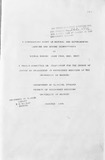| dc.description.abstract | A survey on the incidence of besnoitiosis in the domestic ruminants in Kenya was conducted for two years. A total of 29 districts were visited and 38,577 goats, 16,014 cattle and 14,818 sheep were examined for cysts in the eye as recommended by Bigalke and Neude, (1962). To confirm diagnosis skin biopsies were taken and histopathology done.
The survey showed that besnoitiosis was most important in goats, followed by cattle, while sheep were free. Caprine besnoitiosis occurred in a continuous belt from the Coast, North Eastern, Eastern, Southern Rift Valley, Nairobi and Northern Rift Valley. The highest infection rate was found in Mandela - 36.8 per cent; followed by Kwale - 35.2 percent; Isiolo - 34.8 percent; Marsabit - 33 percent; Wajir - 28 percent; Nairobi 25.6 percent; Meru -24.4 percent; Garissa - 21 percent; Taita Taveta - 18 percent, Embu - 16.7 percent; Kitui - 8.6 percent; Machakos - 6.5 percent; Laikipia - 2.8 percent, Ka-jiado - 1.6 percent; Turkana - 0.9 percent and Elgeyo- Marakwet - 0.8 percent. In all districts (except Nairobi) where caprine infection rates were above 6.0 percent kids were infected.
Bovine besnoitiosis was only found in Tana River district where an infection rate of 11.1 percent was found. Goats in this district were free from besnoitiosis. Sheep from all the provinces were found to
xxiv
be free from besnoitiosis.
Acute besnoitiosis, hitherto unreported was observed in goats. They had fever (>40.5*C), anorexia, lacrimation, dull demeanour and anasarca. In bucks the testis were swollen and painful to touch. Chronic caprine besnoitiosis was characterised by alopecia, hyperkeratosis and scleroconjuctival cysts. The following semen characteristic indices were found to be low in the chronically sick bucks; Sperm counts (0- 1.5x10*); Individual sperm motility (0-80 percent) and live spermatozoas (0-85 percent). The semen also had no motion of swirl and the sperms had a high defect rate (50 percent) . | |

